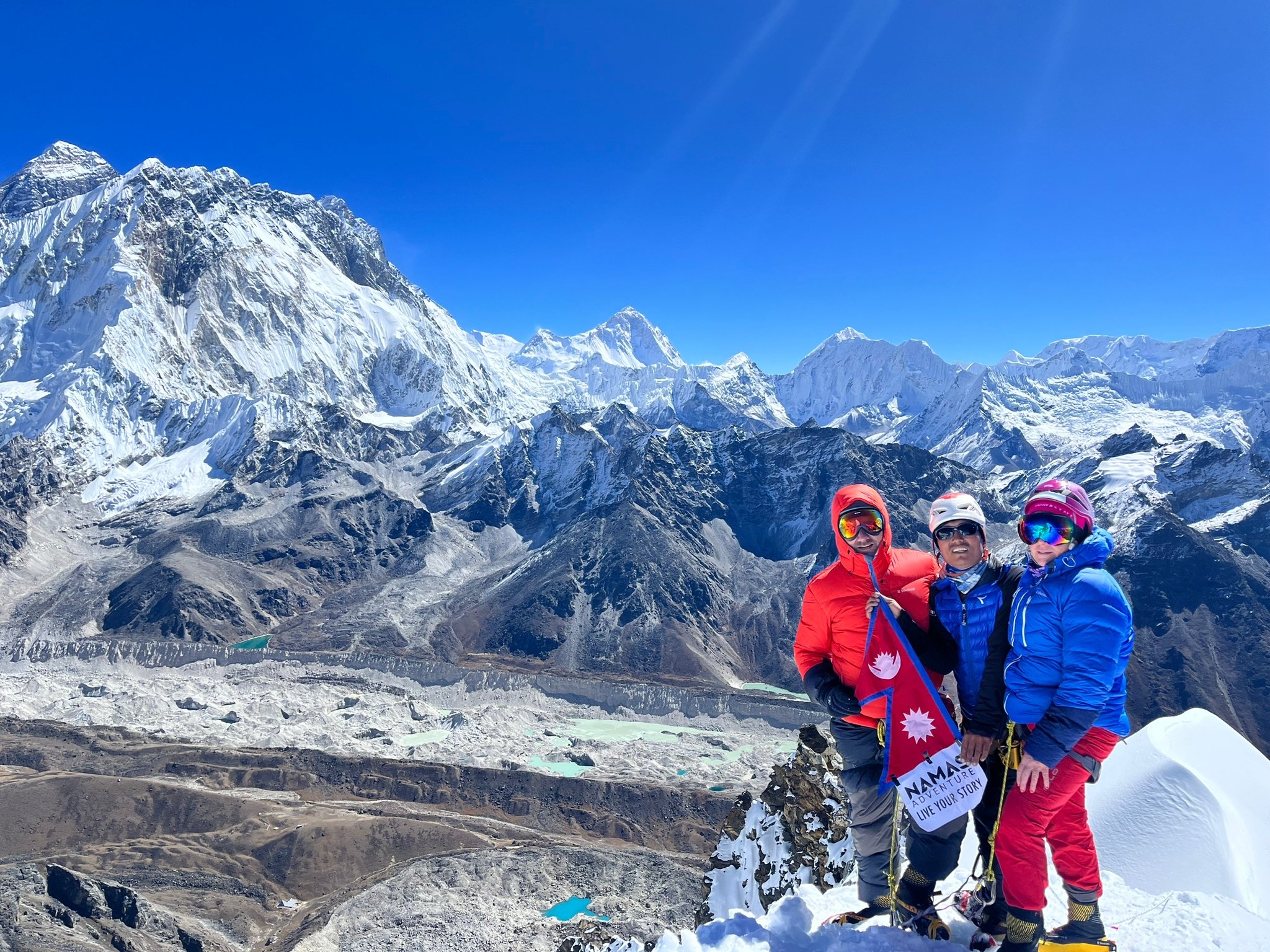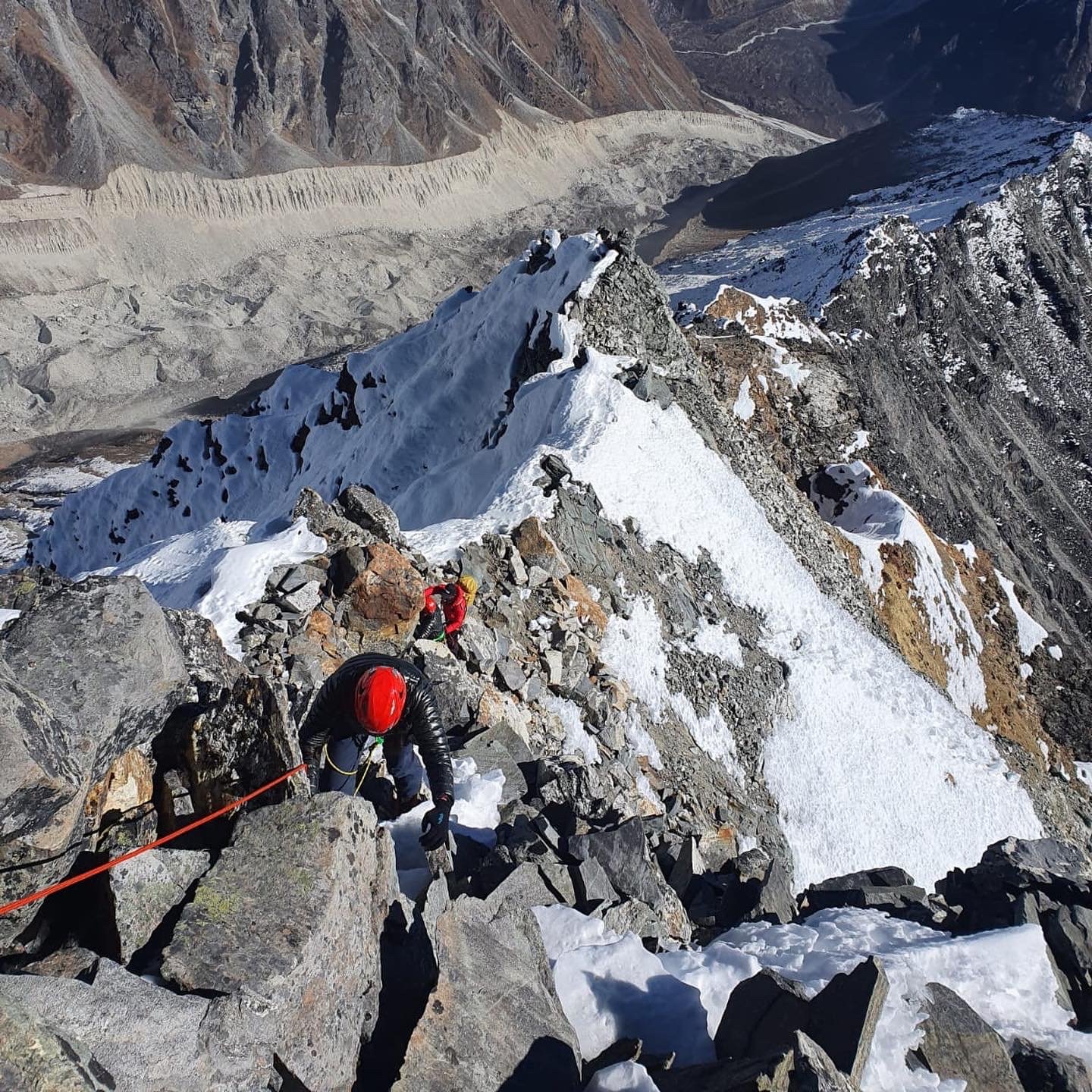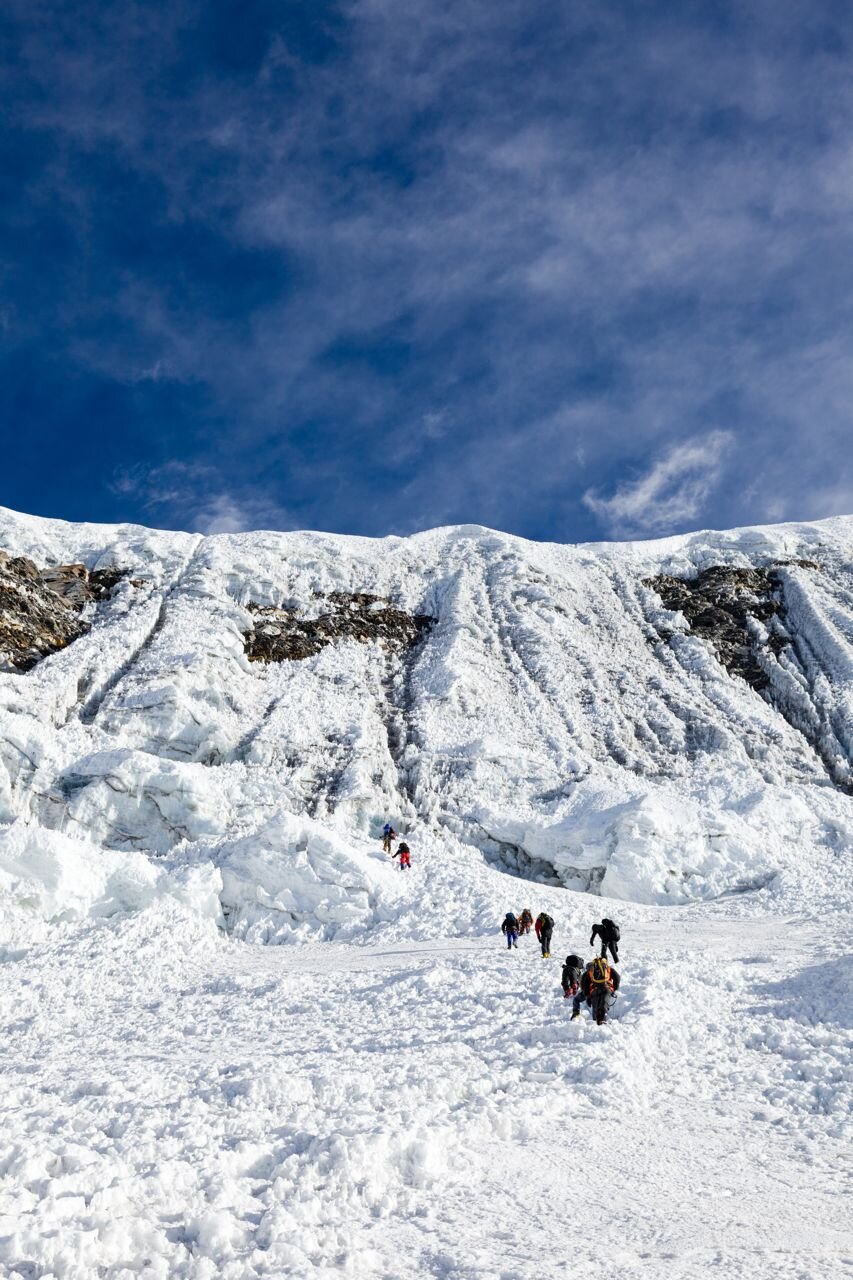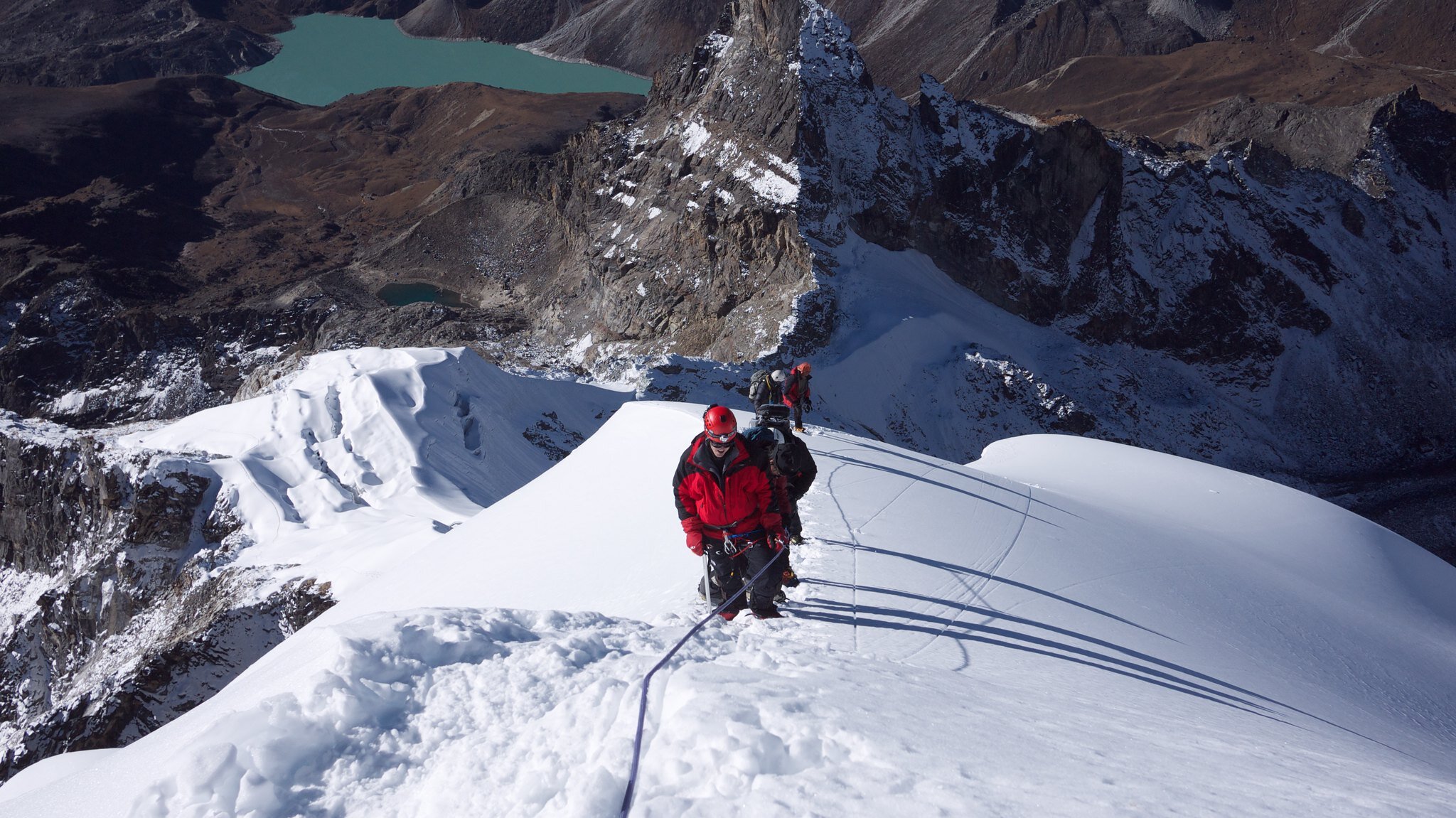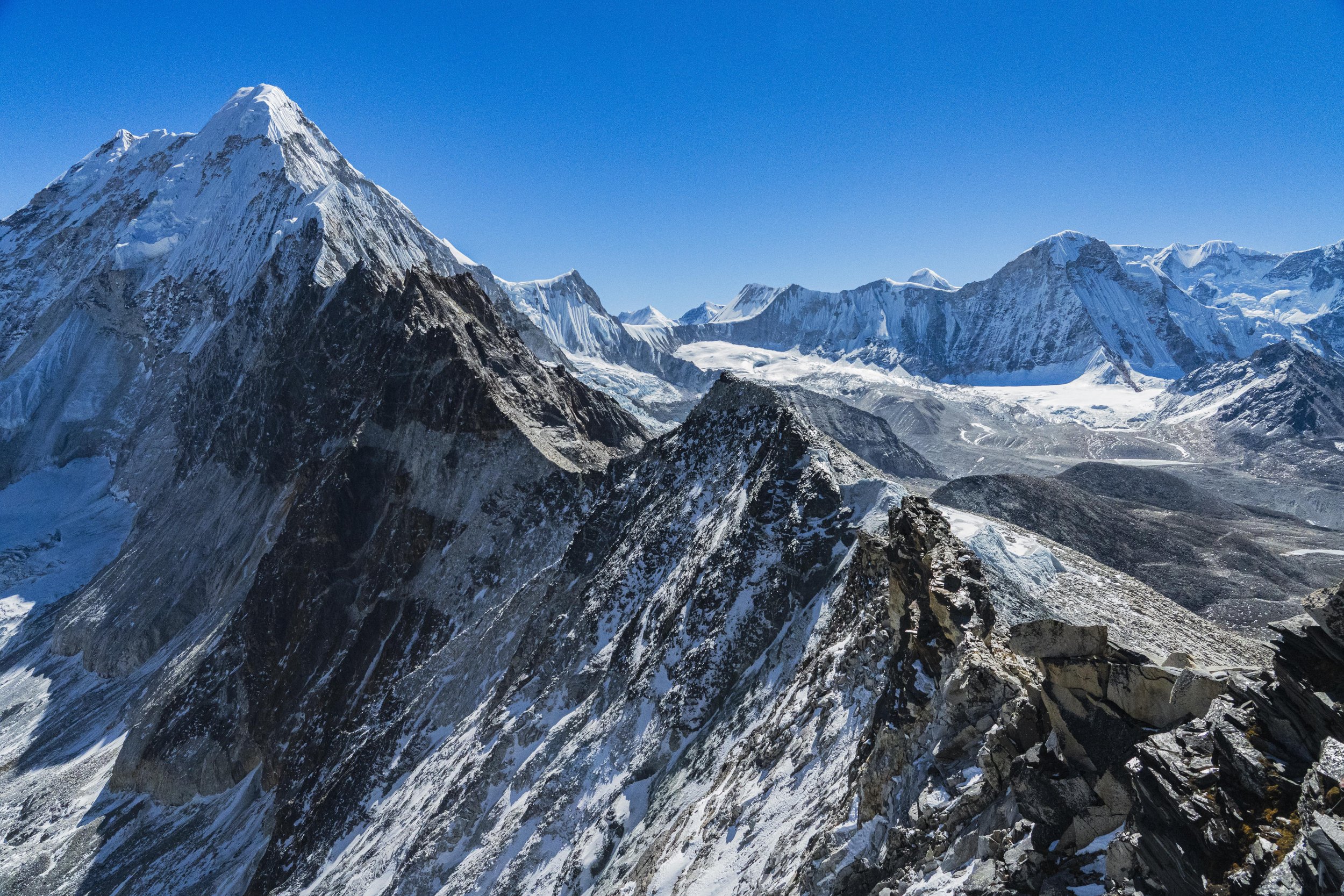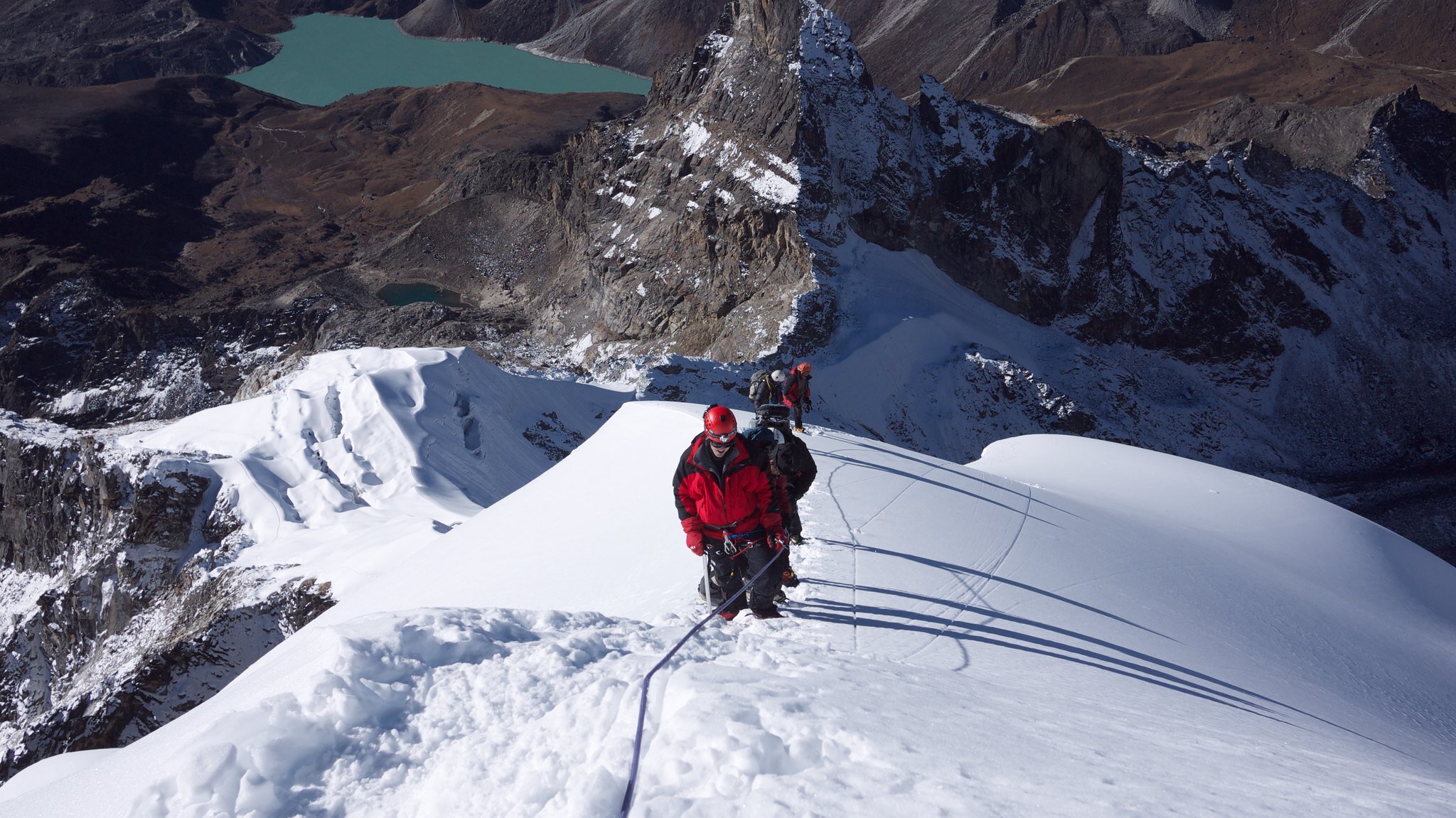A beginner and intermediate's guide to climbing 6000 meter peaks in Nepal during spring season - Namas Adventure
Lobuche East
Climbing the giants of the Nepalese Himalayas is a dream for many adventurous souls. With elevations reaching up to 8,000 meters, these peaks are not only challenging but also require proper planning and preparation. However, climbing peaks of around 6,000 meters can also be a rewarding experience for beginners and intermediates alike, especially during the spring season in Nepal.
March to May and Mid October - Mid December, is considered the best time to climb these peaks as the weather is great, and the snow is firm enough for climbing. The period also offers clear views and friendly trekkers along the trails.
In this guide, we will look at some of the best beginner and intermediate 6000-meter peaks to climb in Nepal during the spring season.
beginners/novice
Mera Peak (6,476 meters)
Mera Peak is the highest trekking peak in Nepal, located in the Makalu region. The peak is a perfect choice for beginner-level climbers who want to experience the thrill of climbing in a remote area. The climb is challenging, with steep sections of ice and snow, but the summit provides a breathtaking view of the surrounding peaks, including Mount Everest, Lhotse, and Makalu.
Lobuche East (6,119 meters)
Lobuche East 6119M is a popular peak located in the Khumbu region. It is considered a moderate climb with a relatively straightforward route. The peak offers a breathtaking view of the surrounding peaks, including Mount Everest, Lhotse, and Nuptse. The peak can be reached via the Gokyo and Everest Base Camp trek
Island Peak (6,189 meters)
Also known as Imja Tse, Island peak is a popular climbing peak. It is considered one of the easiest 6000-meter peaks to climb, with a moderate level of technical difficulty. The peak is located in the Khumbu region and can be reached via the famous Everest Base Camp trek.
The climb is relatively straightforward, and the summit provides a panoramic view of the surrounding peaks such as Lhotse Sharr and Ama Dablam.
Chulu Far East (6,019 meters)
Chulu Far East peak is a high-altitude trekking peak in the Annapurna circuit region. A non-technical and straightforward climb, making it accessible to those without previous technical climbing experience. However, the steep terrain and scree slopes encountered during the approach can make the climb more challenging. It is very similar to Mera Peak expedition.
The Chulu Far East Peak climb itinerary offers climbers the opportunity to witness the stunning natural beauty of the Annapurna region. The summit provides panoramic views of Annapurna II, III & IV, Gangapurna, Manaslu 8163M, Pisang Peak, Chulu West Peak, and Dhaulagiri, as well as the plains of Tibet to the north. You can also further extend your trip to visit the emerald Tilicho lake 4900M and cross the Thorong-la-pass to enter into the forbidden Kingdom of Upper Mustang.
Yala Peak (5732 meters)
Yala Peak, standing at 5732 meters, is a part of the Langtang Lirun Himal range and is situated in close proximity to the Tibetan border. The peak offers a non-technical climb, making it an ideal terrain for novice climbers to gain experience and explore the world of mountaineering.
The base camp for the expedition is located at an altitude of 4500 meters and offers spectacular views of nearby peaks such as Langtang Lirung, Lenpo Gang, Dorje Lakpa, and the majestic Sishapangma on the Tibetan side.
intermediate
Chulu West Peak (6,419 meters)
Chulu West peak is an exhilarating 6000-meter-plus climbing peak in the mid-western part of Nepal. This peak is less frequently visited and attracts fewer climbers. Climbers embark on their peak climbing adventure by setting out to Chulu base camp from Ledar village, passing through one of the world's most beautiful trekking routes. The peak sits against the stunning backdrop of the Annapurna massif range, with the Himlung Himal to the northeast and the majestic Manaslu peak in the distance.
In conclusion, climbing 6000-meter peaks in Nepal during the spring season is a fantastic way to experience the thrill of climbing in the Himalayas. The peaks we listed above offer a challenging yet manageable climb for beginners and intermediates alike, with breathtaking views of the surrounding landscapes and mountain peaks. It is important to take note that climbing any peak in the Himalayas should not be taken lightly and having a knowledgeable guide and proper gear is crucial. Always make sure to acclimatize properly, have fun, pay attention to the guide’s instructions, and have an amazing experience of climbing in the Himalayas.
Are you interested in visiting Nepal during the spring season and climbing your first 6000-meter peak in the Himalayas? Our experienced team who have been making summit dreams true for the last 15 years is here to help make that dream a reality. Who knows, after your first climb, you may be inspired to tackle even more challenging peaks like Everest. Let's make it happen together!
“Do or Do not, there is no try” - YODA
Namas Adventure Team
Climbers Guide: Lobuche East 6119M and Island Peak 6189M Expedition - Namas Adventure
About the Mountains
Lobuche East Peak 6119M is one of the most popular 6,000+ m climbing peaks in Nepal. The peak is mostly used by Everest summit teams as one of the training peaks before making attempting the summit. Our team will set up base camp and high camps when summiting this peak. This peak is a semi-technical climb where most of the technical section only falls after high camp to summit.
Mountain Overview
Lobuche East Peak
Elevation: 6119M / 200075FT
Co-ordinates: 27.9595° N, 86.7899° E
Location: Khumbu Region
Parent Mountain: Lobuche
Summits: 1 summit and extension Lobuche West Summit
Country: Nepal
Island Peak 6189M (Imja tse) is another popular 6,000M+ climbing peak in Nepal. The peak is an extension of the ridge coming down off the south end of Lhotse Shar. Imja Tse is a popular mountaineering objective for climbers, with its standard climbing route having the difficulty rating of Alpine 2B. The final vertical wall to the summit is the only major challenge when climbing this peak. Some season sees glaciers opening where ladders have to be fixed to cross or climb the glacier to follow the route. But this changes every season.
Mountain Overview
Island Peak (Imja Tse)
Elevation: 6189M / 20305FT
Co-ordinates: 43.6605° N, 70.1907° W
Location: Imja Valley
Parent Mountain: Lhotse Shar
Summits: 1 main summit
Country: Nepal
History
The first recorded ascent of Lobuche East was made by Laurence Nielson and Sherpa Ang Gyalzen on April 25, 1984.
The team who first climbed Imja Tse or Island peak comprised Tenzing Norgay, Charles Evans, Alfred Gregory, Charles Wylie, and seven other Sherpas.
How to get here?
There are two main routes to get to Lobuche East and Island Peak
Via Mera Peak and Amphu Lhabtsa pass (Three Peak Expedition)
Via Lukla
Are permits required?
Yes, permits are 100% required. Permit costs $250 USD (Spring) and $125 USD (Autumn) Per person.
Climbing Routes
Lobuche East Peak 6119M: South East ridge (PD) grade.
Island Peak 6189M Peak: South West ridge (PD) grade.
Express Itinerary
With the use of helicopters after the summit, the expedition can be shortened up to 20/21 days. Flying from either peaks Base camps to Lukla.
Further extensions
+ Add Mera Peak (Three Peak Expedition)
Khumbu Three peak expedition program is the holy grail and the best possible introduction to Himalayan climbing - we ascend three beautiful 20,000 foot (6000+ meter) peaks which is one of the most spectacular settings in the world. Join this trip to trek through the hidden gems of the Everest region, Gokyo lake, and three high passes, experience the mountain and Sherpa culture, and an amazing feat of climbing Mera Peak (6,476M), Island Peak (6189m), Lobuche East (6119m).
Baruntse 7129M Expedition
Baruntse Peak is a 7000er mountain peak located just between the ever famous Khumbu region and the raw Makalu region. This peak range forms a giant wall seperating the two region. Crowned by four peaks and bounded on the south by the Hunku Glacier, on the east by the Barun Glacier flowing north-south from Cho to the north-west by the Imja glacier, and the Hunku glacier forms the south-east boundary. Baruntse mountain stretch has four ridges and four summits. The three main ridges are situated between the glaciers, the fourth main summit lies to the west near Cho Polu peak. More detailed informations about Baruntse Expedition in the link below
Ama Dablam 6810M Expedition
Ama Dablam is well renowned as one of the most beautiful and exposed Himalayan mountain in the Everest region. It is one of the most sought mountains to climb by mountaineering enthusiasts. Whether you plan to do it before or after your bigger expedition like Everest, Ama Dablam climb in itself is a mountaineering challenge on its own. Ama Dablam climb is considered "a must-do" for alpinist and mountaineers.
Other highlights during these expeditions
✅Tenzing Hillary ✈️Lukla Airport 2800M
Land in Lukla 2845M, Tenzing - Hillar airport. Day 3 of your itinerary and where your adventure begins.
✅Namche Bazzar 3375M
Namche Bazaar 3440M. Hub of Everest region and home to Sherpas.
After trekking through lush jungles and flowing rivers on the 5th day of the itinerary climbers will stop by at Namche Bazaar for their acclimatization day. There are lots to explore on your acclimatization day. Climbers will hike up to Everest view Hotel and explore Khumjung village experiencing the lifestyle and culture. Find amazing cafes, bars, and our recommendation Sherpa Barista restaurant for delicious food. (Pizza, Biryani are a must)
✅Gokyo Lake 4900M
Emerald lake Gokyo seen from Gokyo ri falls on the Itinerary
Panoramic view from Gokyo Ri
The emerald Gokyo lake is one of the most stunning high-altitude glacier lakes in Khumbu. Gokyo Ri 5375M is a viewpoint where the long Khumbu Himalayan range can be seen. (Image above)
✅Ultimate Bucket List - 🏔Everest Base Camp 5346M
The iconic Everest base camp is filled with expedition teams during spring whereas in autumn with no Everest expedition it is just an empty vast glacier land. The mighty flowing Khumbu icefall is visible upon reaching the base camp. EBC ticked off from your bucket list during this expedition.
Want to plan your expedition to the Lobuche East and Island Peak expedition in Nepal? For more information on our Khumbu Three Peak expedition or any of our other international expeditions check out our website. (Call/WhatsApp) - +44 7446976060 or send us an email at bookings@namasadventure.com
What’s stopping you? Go. Explore more.
Live Your Story
Visual Journey, Khumbu Three Peak Expedition, Nepal - Namas Adventure
Khumbu Three peak expedition program is the holy grail and the best expedition program for anyone seeking long mountain adventure days and a feast of Himalayan climbing experience. Climbers will summit three beautiful 20,000 foot (6000+ meter) peaks which is one of the most spectacular settings in the world. Trekking through the hidden gems of the Everest region, Gokyo lake, and three high passes, experience the lifestyle in the mountains, witness Sherpa culture, and an amazing feat of climbing Mera Peak (6,476M), Island Peak (6189m), Lobuche East (6119m).
Climbers pass through several beautiful villages of Khumbu and Makalu/Barun valley. Once climbers arrive at the base of each peak alpine camping beings. The expedition is suitable for anyone with beginner to intermediate skill levels. Past experience is not mandatory but climbers must have very good endurance fitness since this is a month-long expedition. Expect a little bit of everything on the route – scrambling on the rock, climbing on steep ice/snow, and multiple camps on the mountain. Follow along as we describe the entire journey in images, as we take the beautiful yet challenging journey up to the summit of three amazing peaks in Nepal.
Land in Lukla 2845M, Tenzing - Hillar airport. Day 3 of your itinerary and where your adventure begins.
Day 3 Luka to Paiya - Day 10 Khare 5000M acclimatisation and training for Mera Peak
Day 11 High camp - Day 15 Amphu Lhabtsa pass
Mera high camp 5800M is one of the iconic high camps. Climbers will come across the final or beginning leg of their Khumbu Three Peak expedition. Out of all the three summits, Mera peak summit offers the most grander view of the Himalayas. Most of the 8000M+ in the Khumbu and Makalu region can be seen. On the left Cho-Oyu, Everest, Lhotse, Makalu to Kanchenjunga in the far right hand side. Chamlang another 7000M+ peak can be seen in front (slightly to right) from the summit and other Himalayan peaks are clearly visible. On a clear summit day, the view is something out of this world.
Summit of Mera Peak 6476M
Himalayan panoramic view from Mera Peak summit 6476M.
Climbing and crossing the challenging Amphu Lhabtsa pass 5800M.
Island Peak 6189M (Imja tse) is another popular 6,000M+ climbing peak in Nepal. The peak is an extension of the ridge coming down off the south end of Lhotse Shar. Imja Tse is a popular mountaineering objective for climbers, with its standard climbing route having the difficulty rating of Alpine 2B. The final vertical wall to the summit is the only major challenge when climbing this peak. Some season sees glaciers opening where ladders have to be fixed to cross or climb the glacier to follow the route. But this changes every season.
Lobuche East Peak 6119M is one of the most popular 6,000+ m climbing peaks in Nepal. The peak is mostly used by Everest summit teams as one of the training peaks before making attempting the summit. Our team will set up base camp and high camps when summiting this peak. This peak is a semi-technical climb where most of the technical section only falls after high camp to summit.
Emerald lake Gokyo seen from Gokyo ri falls on the Itinerary
Panoramic view from Gokyo Ri
The emerald Gokyo lake is one of the most stunning high-altitude glacier lakes in Khumbu. Gokyo Ri 5375M is a viewpoint where the long Khumbu Himalayan range can be seen. (Image above)
The iconic Everest base camp is filled with expedition teams during spring whereas in autumn with no Everest expedition it is just an empty vast glacier land. The mighty flowing Khumbu icefall is visible upon reaching the base camp. EBC ticked off from your bucket list during this expedition.
Khumbu Three Peak Expedition
Want to plan your expedition to the Khumbu Three Peak expedition in Nepal? For more information on our Khumbu Three Peak expedition or any of our other international expeditions check out our website. (Call/WhatsApp) - +44 7446976060 or send us an email at bookings@namasadventure.com




